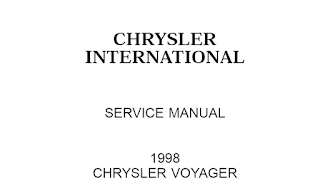 The 1998 Chrysler Voyager Service Manual information contained in this guide was written for professional automotive technicians who are involved in the repair work every day. This guide does not cover the theory of operation, which is discussed in the material service training. Information that describes the operation and use of standard and optional equipment included in the operating instructions with the vehicle. The information in this book is divided into groups. These groups provide general information, diagnostics, testing, adjustment, dismantling, installation, disassembly and assembly procedures for systems and components. Use it to search for the title of the page group tab group in the following pages. Solid bar after the title of the group will be adjusted to keep a tab on the first page of each group. The first page of the group includes the content area that lists the group's main theme. If you are not sure which group contains the necessary information, consult the component/system in the alphabetical index at the back panel of this manual.
The 1998 Chrysler Voyager Service Manual information contained in this guide was written for professional automotive technicians who are involved in the repair work every day. This guide does not cover the theory of operation, which is discussed in the material service training. Information that describes the operation and use of standard and optional equipment included in the operating instructions with the vehicle. The information in this book is divided into groups. These groups provide general information, diagnostics, testing, adjustment, dismantling, installation, disassembly and assembly procedures for systems and components. Use it to search for the title of the page group tab group in the following pages. Solid bar after the title of the group will be adjusted to keep a tab on the first page of each group. The first page of the group includes the content area that lists the group's main theme. If you are not sure which group contains the necessary information, consult the component/system in the alphabetical index at the back panel of this manual.
Tightening torque is given in this document as a specific value. This value is the center of various designs of torque received is for particular fastening applications. Torque values are intended for use in the assembly of the service and the installation using the correct OEM fasteners. When replacing fasteners always the same fastening device (Part Number) as deleted. Chrysler International reserves the right to modify the test methods, specifications, diagnostics, repair methods, or wiring the vehicle at any time without notice or obligation. A certificate of vehicle safety (Fig. 1) is located at the back of the driver's door. This label indicates the date of manufacture (month and year), gross vehicle weight (GVWR), gross axle (GAWR) and the vehicle identification number (VIN). Month, day and hour of production is also included. If necessary, the manufacturer for service or warranty for contact information about vehicle safety certificate required.
Vehicle identification number (VIN) can be seen through the glass in the upper left corner of the dashboard, the windshield around the left (2). VIN consists of 17 characters in a combination of letters and numbers that provide specific information about the vehicle. See the chart Breakdown VIN code for decoding the information. To protect consumers against theft and fraud are possible, the manufacturer must provide a check digit in the ninth position of the vehicle identification number. The check digit is used by producers and the authorities to verify the authenticity of the vehicle and official documentation. The formula for the use of the check digit is not visible to the public. Body Code Plate (Fig. 3) located in the engine compartment on the radiator cross member closing panel. There are seven lines of information on weight-coded plates. Line 4, 5, 6 and 7 are not used to define information services. Information is read from left to right, starting with line 3 in the middle of the plate to one line at the bottom of the plate.
This 1998 Chrysler Voyager Service Manual covered Introduction, Lubrication and Maintenance, Suspension, Brakes, Clutch, Cooling System, Battery, Starting System, Instrument Panel and Systems, Vehicle Speed Control System, Wiper and Washer Systems, Lamps, Vehicle Theft/Security Systems, Chime Warning/Reminder System, Wiring Diagrams, Engine, Frame and Bumpers, Fuel System—2.5L Diesel Engine/2.0L Gas Engine, Steering, A—598 Manual Transaxle, Body, Heating and Air Conditioning, Emission Control System.
Download 1998 Chrysler Voyager Service Manual
0 Response to "1998 Chrysler Voyager Service Manual"